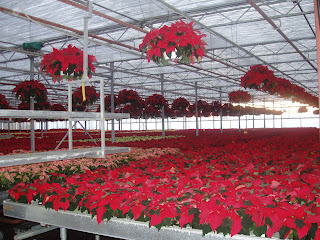One of the perks of my job is getting free plants. Much to the frustration of my boyfriend Kevin, I always seem to be coming home with a carload of plants given to me by local nursery growers and plants from finished research projects that I’ve saved from becoming part of the fateful compost pile. Unfortunately, my townhouse condo is not very conducive to plant hoarding – with a front yard full of plants already, I am left with container gardening on the back deck or tending indoor plants. Thankfully, this last plant I brought home – a lovely poinsettia (NOT a point-setta, ahem) – was an indoor one. As I drove home from work the other day with my new poinsettia, not only was I thinking my typical thought of, “Where the heck am I going to put this one?”, but I was also thinking about the poinsettia itself…
Photo: Poinsettias often come in brilliant red or snowy white, but can also be marbled, speckled, or even pink.
Poinsettia (Euphorbia pulcherrima) is a tropical flowering plant native to Mexico and Central America. Apparently it has been used in Mexican Christmas celebrations since the 17th century. Poinsettias make the perfect Christmas plants with their star-shaped leaf arrangement said to symbolize the Star of Bethlehem, and their red color said to symbolize the blood of Christ.
The poinsettia I just brought home from work also originally came from overseas. As a small, easily transportable cutting, it was shipped from the tropics all the way here to Long Island. Care had to be taken to make sure that the little plants did not dry out, overheat, or freeze during transport. When the shipment arrived in August at our research lab in Riverhead, Christmas seemed far, far away. Over the next 4 ½ months, our Floriculture Specialist, Nora Catlin, tended over the plants with the care and fastidiousness of a new mother. Each baby poinsettia received a prescribed watering regimen, nutrient program, and integrated pest control. As the little poinsettias grew larger in the temperature-controlled greenhouse, the end buds were “pinched” off to increase branching and develop a fuller plant.
The months passed quickly and as Christmas drew nearer, perfect care of the poinsettias became critical. If the air temperature of the greenhouse was too low or there was not enough fertilizer applied, the poinsettias could end up too small. But if the temperature was too high or too much fertilizer was applied, the poinsettias could come out leggy and too big for their pots. Getting the leaves or bracts to change color from green to red or white in time for Christmas was also critical. By increasing the length of darkness at night by using a greenhouse shade cloth, and by increasing the intensity of light during the day, the poinsettias turned a brilliant red or snowy white color. There were also some really neat poinsettia cultivars that revealed a unique marbled or speckled pattern on their bracts or even changed to pink instead.
Photo: Poinsettias inside a commercial greenhouse on the North Fork, Peconic
Perfect in size and color, Nora’s poinsettias shined festively in neat little rows inside the greenhouse, just in time for Christmas. These poinsettias joined the nearly 1.5 million poinsettias grown every year here on Long Island. So the next time you buy a poinsettia, remember all the hard work that went into growing it and making it ready for the holidays. Now that the hard work is done, it’s time for us to relax and enjoy all that the season has to offer. Merry Christmas and Happy Holidays!

